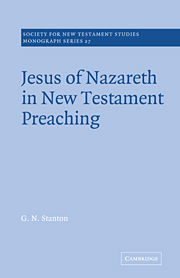Book contents
- Frontmatter
- Contents
- Preface
- Abbreviations
- Introduction
- 1 Jesus of Nazareth in missionary preaching: Luke's view
- 2 Luke's presentation of Jesus in his Gospel
- 3 Pre-Lucan traditions about Jesus in the speeches in Acts
- 4 Jesus in Paul's preaching
- 5 The gospels and ancient biographical writing
- 6 Jesus in the gospel traditions
- 7 The gospel traditions in the early church
- Conclusions
- Index of passages cited
- Index of authors
- General Index
7 - The gospel traditions in the early church
Published online by Cambridge University Press: 04 October 2009
- Frontmatter
- Contents
- Preface
- Abbreviations
- Introduction
- 1 Jesus of Nazareth in missionary preaching: Luke's view
- 2 Luke's presentation of Jesus in his Gospel
- 3 Pre-Lucan traditions about Jesus in the speeches in Acts
- 4 Jesus in Paul's preaching
- 5 The gospels and ancient biographical writing
- 6 Jesus in the gospel traditions
- 7 The gospel traditions in the early church
- Conclusions
- Index of passages cited
- Index of authors
- General Index
Summary
Why did the early church retain traditions about Jesus? How did the evangelists use the traditions on which they drew? Ever since the form critical ‘revolution’, most scholars have accepted that the gospel traditions were retained by the early church in order to meet its interests and needs. The traditions, form critics insist, are kerygmatic in the broadest sense of that term; they are not a neutral record of the historical Jesus, but were shaped and sometimes created in the light of the church's faith in the Risen Christ and were used to support and supplement the church's proclamation. Many scholars, following R. Bultmann's lead, have taken a further step and have denied that the gospel traditions intended to set out the life and character of Jesus: they are not concerned with the past, but with the church's present experience of and faith in the Risen Christ of the kerygma.
There is no need to quarrel with the form critical axiom that the traditions are kerygmatic. But, if the conclusions of the two previous chapters are valid, the kerygmatic role of the traditions has not smothered interest in the life and character of Jesus. The dual perspective of the gospel traditions is inescapable; they are kerygmatic and they intend to sketch out the life and character of Jesus.
- Type
- Chapter
- Information
- Jesus of Nazareth in New Testament Preaching , pp. 172 - 185Publisher: Cambridge University PressPrint publication year: 1975

